The Chinese Meteorological Society
Article Information
- CHEN Zitong, ZHANG Chengzhong, HUANG Yanyan, FENG Yerong, ZHONG Shuixin, DAI Guangfeng, XU Daosheng, YANG Zhaoli. 2014.
- Track of Super Typhoon Haiyan Predicted by a Typhoon Model for the South China Sea
- J. Meteor. Res., 28(4): 510-523
- http://dx.doi.org/10.1007/s13351-014-3269-2
Article History
- Received March 2, 2014;
- in final form May 28, 2014
1. Introduction
The land fall of a typhoon can be hugely disastrous, and so forecasting the track of typhoons haslong been a focus for scientists working in this field ofresearch. Kasahara(1957)developed a typhoon modelbased on the relationship between the movement speedof the typhoon and the velocities generated by thesteering and internal forces of the basic current. InChina, the forecasting of typhoon tracks using numerical weather models has been studied since the 1960s. However, owing to the limitations of computer hardware and other related technologies, the resolutions ofnumerical models for typhoons were very low, and alldiabatic physical processes were still being ignored 20years later in the early 1980s(Ni et al., 1981; Wang et al., 1987). A numerical model containing diabaticphysical processes that could be used for operationalforecasting in the tropics(Xue et al., 1988)was laterdeveloped by the Guangzhou Institute of Tropical and Marine Meteorology(ITMM); however, its resolutionwas low and its physical processes were not complete, and so the gap between this model and other advanced models developed in other countries was relatively large(Xue et al., 1996). The parameterizationof physical processes in numerical weather models, aswell as computer capabilities, have developed considerably since the 1980s, and so more recently it hasbeen possible to increase the resolution of models and introduce much more realistic physical processes. Infact, numerical models have been used in China forreal-time operational forecasts of typhoon tracks sincethe 1990s(Wang and Li, 1994; Xue et al., 1996). Theforecasting of typhoon tracks is quite sensitive to theparameterization schemes of physical processes in themodel, as well as its resolution(Wang and Li, 1994), so the quest for higher resolution and more realisticphysical processes has never ceased(Zhu et al., 1982; Chen et al., 1996; He, 2006; He et al., 2011). Simulating typhoons at higher resolutions has become possiblewith the advent of supercomputers at the beginning ofthe present century, and great progress has been madein countries such as the USA, UK, and Japan in forecasting typhoons with numerical models(Chen, 1995).
Research on the forecasting of typhoon tracks us-ing numerical models began earlier and has developedto a more mature state than the forecasting of typhoonintensity, both in China and in other countries. Theforecasting of typhoon intensity, including changes inintensity, and especially rapid intensification, has become an increasing concern in recent years. For example, Pun et al. (2013)pointed out that the latent heatreleased by a tropical cyclone(TC)was very high overthe northwestern Pacific, which is conducive to therapid intensification of tropical cyclones. Kaplan and DeMaria(2003)analyzed the large-scale characteristics of TCs that strengthened rapidly over the northern Pacific, and developed a method to predict theirrapid intensification. High-resolution numerical models are more suitable for exploring intensity changesof typhoons. Rogers(2010)successfully simulated thetrack, intensity, and intensity change(during the period of rapid intensification)of Hurricane Dennis usingthe MM5 model with a resolution of 1. 67 km. Chen etal. (2011)studied Hurricane Wilma, which occurredin 2005, with the WRF-ARW model(using the bidirectional feedback setup and movable nested gridswith a maximum resolution of 1 km), and demonstrated that the rapid intensification and weakeningprocesses of the TC could be successfully simulated. The relationship between convective bursts(CBs)inthe eyewall and the upper-level warm core has beenstudied(Zhang and Chen, 2012; Chen and Zhang, 2013), and it is found that the upper-level warm coreplays an important role in the rapid intensification ofhurricanes.
At present, operational numerical models usedin China are more capable of forecasting a typhoon'strack than its intensity, especially for super typhoons. This problem is reflected in the forecasts of TyphoonMegi in 2010 and Haiyan in 2013. The shortcomingsin typhoon intensity forecasts will also impact uponthe accuracy of other elements, such as the typhoon'strack and the associated wind and rain. Many studieshave been carried out on the simulation of the intensityof Saomai, which made l and fall in China in 2006(e. g., Yu et al., 2008; Ma et al., 2009; Shi et al., 2009; Xu et al., 2010). Simulations with the MM5(v3. 5), ARPS, and WRF models(Yu et al., 2008; Ma et al., 2009; Shi et al., 2009)have all shown too weak an intensity compared to observations, which further causes bias in theforecasting of the typhoon's track, wind, and precipitation. The forecasting of super typhoons is greatlyaffected by the assimilation of high-resolution observational data, typhoon initialization technology, and theperformance of the model's framework(especially thephysical processes). Due to a lack of detailed studieson the occurrence and development mechanisms of super typhoons over the ocean, there are currently manydeficiencies in the design of the physical processes usedfor forecasting track and intensity of super typhoons.
In the past 20 years, great progress has been madein China with respect to the operational forecastingof typhoons using numerical models, and the performance of an early(prior to 2006)typhoon model developed by the ITMM for the South China Sea hasbeen enhanced through significant efforts over severalgenerations of research. A new tropical regional atmosphere model for the South China Sea(TRAMS)wasestablished based on the GRAPES framework in 2006. Since then, it has been regularly developed to becomeone of the main operational typhoon models used inChina.
Super Typhoon Haiyan was the most notable typhoon in 2013. It formed over the northwestern Pacific on 4 November, and then rapidly strengthened toa super typhoon on 8 November. Haiyan made l and fall in the Philippines, with the strongest wind forceon record and large-scale storm surges, causing devastating damage in the central part of the Philippines. According to an estimation from the U. S. Joint Typhoon Warning Center, the maximum wind force ofHaiyan reached 75 m s-1 when it moved near to thecentral and southern isl and s of the Philippines, and made l and fall at a speed of over 300 km h-1, which wasfar higher than Hurricane Katrina, which made l and fall first in Florida, USA in 2005. Both Haiyan and Katrina were super typhoons(hurricanes)that causeddevastating destruction over multiple l and fall events. Haiyan made l and fall in the Philippines at the superlevel on 8 November, and then its intensity weakenedbefore making l and fall again in northern Vietnam on11 November.
The track of Haiyan was successfully forecastedby many operational numerical models(includingTRAMS), but its forecasted intensity was too weakcompared to observations. In addition, the disastrousimpacts of Haiyan became heavier due to the fastspeed of movement of the typhoon and the topography of the Philippines. Hurricane Katrina was alsoa super typhoon, with wind speed reaching 225 kmh-1 when it made l and fall in Louisiana. The forecastof Katrina's track and intensity by the U. S. NationalHurricane Center was practically flawless. On 26 August(3 days in advance), it was predicted that therewould be a 90% probability that the hurricane wouldpass directly through New Orleans, and this of coursewas hugely helpful in terms of winning time to alleviatethe disaster. The greatest losses were mainly causedby the strong storm surge, the bursting of flood banks, and disorder in disaster prevention attempts.
The purpose of analyzing the track forecast ofHaiyan in this paper is to underst and the skill and problems that exist in TRAMS, thus hopefully providing relevant clues for developing new operationaltyphoon models, and giving some reference for supertyphoon forecast services. In Section 2, we brieflydescribe the characteristics of Haiyan. The track ofHaiyan and its forecast by TRAMS is then examined and summarized in Section 3. In Section 4, we analyzethe underlying physical mechanisms through numerical experiments and the technical schemes for improv-ing the skill of the forecast. Finally, in Section 5, wepresent some further discussion and a summary of thekey findings. 2. Characteristics of Super Typhoon Haiyan
Super Typhoon Haiyan formed over the north-western Pacific(6. 1°N, 152. 2°E)at 0000 UTC 4November 2013. It moved in an NWW direction and strengthened rapidly to become a strong tropicalstorm at 1800 UTC 4 November, a typhoon at 0600UTC 5 November, a strong typhoon at 1800 UTC 5November, and finally a super typhoon, with a minimum central pressure of 950 hPa and maximum central mean wind speed of up to 55 m s-1, at 0000 UTC6 November. Haiyan made l and fall in the Philippinesat the super typhoon level at 2300 UTC 7 November(Fig. 1), with its minimum central pressure and maximum ground wind speed in the inner core of the typhoon reaching 890 hPa and 75 m s-1, respectively. At0600 UTC 8 November, Haiyan weakened to a typhoon and entered the South China Sea at nighttime on 8November, after which it approached the oceanic areanear the Xisha Isl and s. It then moved into the BeibuGulf after grazing the southwestern part of HainanIsl and in the afternoon of 10 November, before weakening to a typhoon at 1300 UTC 10 November. At2100 UTC 10 November, Haiyan made l and fall againin the coastal area of Quang Ninh Province in northern Vietnam. The maximum wind speed and minimum pressure near the center was 38 m s-1 and 965hPa, respectively. Finally, Haiyan entered NingmingCounty, Guangxi, China, at 0100 UTC 11 November, after which it weakened to a strong tropical storm at0200 UTC 11 November, a tropical storm at 0400 UTC11 November, and a tropical depression at 1200 UTC11 November. Haiyan was the strongest typhoon inthe world in 2013, with a maximum wind speed up to75 m s-1 around the time of its l and fall in the Philippines. Due to the influence of Haiyan, wide-ranging and strong precipitation and windy weather occurredover most parts of Guangxi and in the cities and counties of southwestern Guangdong. In general, observational analysis indicates that Haiyan was characterizedby powerful intensity, high speeds of movement, lateseason development, and heavy disastrous impact.
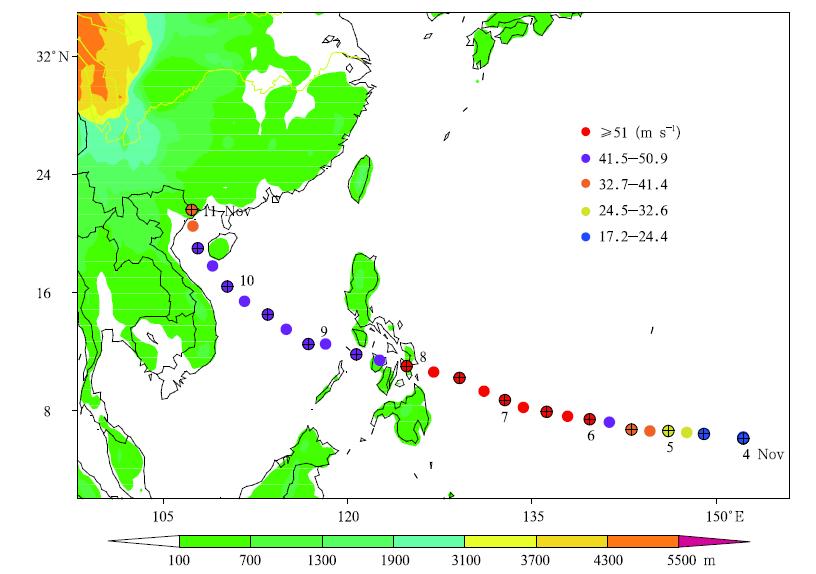 |
| Fig. 1. Track of Typhoon Haiyan. The shadings represent topographic height(m) and the dots represent the position and intensity of Haiyan at 6-h intervals. |
Haiyan formed over the northwestern Pacific tothe east of Indonesia over an obviously warm sea surface. From comparisons between temperature anomalies at the sea surface and changes in the typhoon'sintensity(Fig. 2a), we can see a close relationshipbetween the two variables. The sea surface was relatively warm(positive temperature anomaly)from 1800UTC 5 November to 1200 UTC 7 November, and the typhoon's intensity increased accordingly. Thereafter, the intensity weakened with a decline in sea surface temperature(anomalies being negative or close tozero); thus, a relationship between the development ofHaiyan and the warm sea surface is clear. Recently, ithas been shown that the latent heat released from thewarm sea surface in the northwestern Pacific(with26-isotherm thickness)has a close relationship withthe formation and development of typhoons, especiallysuper typhoons(Pun et al., 2013).
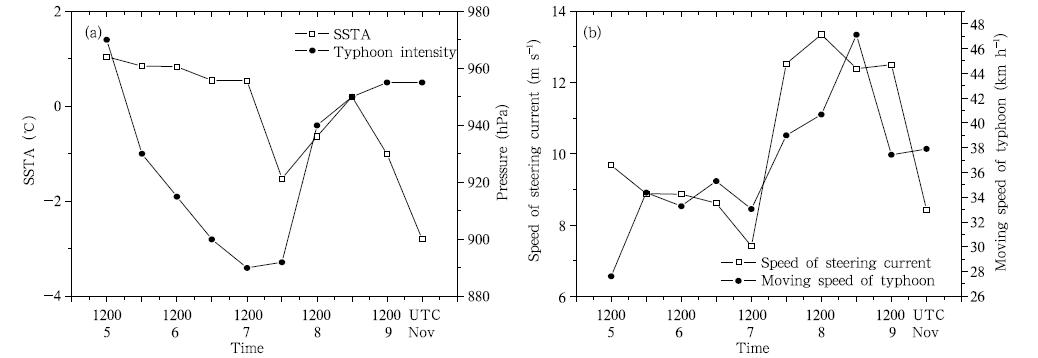 |
| Fig. 2. Time series of the intensity and movement speed of Haiyan during the period 0000 UTC 5 to 0000 UTC 10November. (a)Typhoon intensity and mean sea surface temperature anomaly(SSTA)averaged within a 300-km radius ofthe typhoon center, and (b)movement speed and mean steering current averaged within a 300-km radius of the typhooncenter at 12-h intervals. |
In the present study, from a preliminary comparison of the easterly steering current(mean value of horizontal wind at 500 hPa within a 300 km radius aroundthe typhoon's center) and movement speed of the typhoon(Fig. 2b), we find an apparent correlation between the two features. The speed of the steering current exceeded 10 m s-1 from 0000 UTC 8 November, which maintained until 1800 UTC 9 November, whilethe movement speed of the typhoon within the corresponding period was basically maintained at above 38km h-1. This indicates that the movement speed ofTyphoon Haiyan was mainly influenced by the easterlycurrent on the south side of the subtropical high. 3. Features of the moving track of Haiyan inthe model forecast3. 1 The TRAMS model
TRAMS is a non-hydrostatic regional model, developed on the basis of the GRAPES mesoscale model. TRAMS employs a semi-implicit, semi-Lagrangianscheme for the integration of time. The horizontal gridis designed on a longitude-latitude net and the vertical coordinate is terrain-following. The Arakawa-Cgrid and Charney-Philips vertical layer setup are usedin the horizontal and vertical directions. The modelcovers the range of 0. 8°-50. 5°N, 81. 6°-160. 8°E. Thehorizontal grid interval is 0. 36° and the model is divided into 55 layers in the vertical. The step lengthfor the time integration is 200 s. The Medium-RangeForecast(MRF)model boundary layer scheme, Simplified Arakawa-Schubert(SAS)cumulus parameterization scheme, WRF Single-Moment 6-class(WSM6)microphysics scheme, Specified constants and Layersfor soil(SLAB)l and surface processes, SWRAD shortwave radiation scheme, and Rapid Radiative Transfer Model(RRTM)longwave radiation scheme are allused in the model. TRAMS has been in operationaluse by the China Meteorological Administration since2011. It provides 120-h forecasts twice daily for typhoon track, wind, rain, isobaric surface field, and typhoon intensity. In this paper, only the 48-h forecastoutputs from TRAMS are analyzed. 3. 2 Track forecast
The track of Haiyan was accurately forecasted byTRAMS. For example, the l and fall of Haiyan in themiddle of the Philippines was successfully predicted inthe forecast initiated at 0000 UTC 7 November(Fig. 3). Haiyan entered the South China Sea after passing through the Philippines, and its l and fall in Vietnam after entering the Beibu Gulf was also success-fully simulated in the forecast initiated at 0000 UTC10 November(when Haiyan was near the Xisha Isl and s). Statistics relating to the forecasts of TRAMSfrom 0000 UTC 4 to 0000 UTC 11 November(14 intotal)show that the mean errors of 24- and 48-h trackforecasts were 81 and 157 km, respectively, which weresmaller than those of the forecasts from the EuropeanCenter(EC)global model and the Japan Meteorological Agency(JMA)mesoscale forecast model. Thetrack forecast for Haiyan by TRAMS showed little divergence, which can be seen from the distribution offorecasts initiated at all time points(Fig. 3), especially in the track forecast from the formation of thetyphoon to its l and fall in the Philippines. The characteristics of the track and its l and fall position werealso successfully predicted by TRAMS after Haiyanentered the South China Sea.
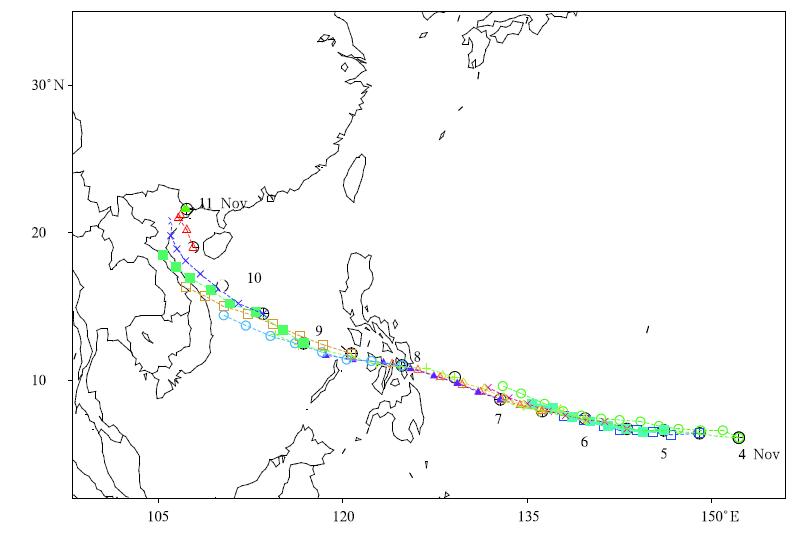 |
| Fig. 3. Distribution of Haiyan's track forecasted by TRAMS from 4 to 11 November. The model was run every 12h, with an integrating time of 48 h, and the forecast position was plotted every 6 h. The numbers in the figure denotedates. Di®erent colors denote di®erent initiation times. |
Various models, including the EC model, JMAmodel, and TRAMS, all forecasted clearly too weakintensities for Haiyan. In our simulation, the meanerrors of the 24-, 48-, and 72-h intensity forecastsin TRAMS reached 21. 65, 30. 71, and 26. 56 hPa, respectively, which were smaller than those in theEC model and JMA model. Nonetheless, the forecasting of intensity for super typhoons is still achallenge for numerical models. The evolution ofHaiyan's intensity can be divided into four stages(Fig. 4). (1)From 0000 UTC 4 to 1200 UTC 5 November, during which time Haiyan strengthened slowly and the errors of forecasted intensities by the variousmodels were relatively small. (2)From 1200 UTC 5 to1200 UTC 8 November, when Haiyan was strengthening rapidly-a process that was too slow in the forecastof the EC model, resulting in the forecasted typhoonintensity being evidently weaker than observed; e. g., the observed intensity reached 890 hPa when Haiyanwas strongest(1200 UTC 7 November), but the bestforecast by the EC model was only 958 hPa(a biasof 68 hPa). The minimum central pressure forecastedby JMA during this period was 983 hPa, with an error up to 93 hPa. TRAMS provided a better prediction, whose minimum central pressure was 923 hPa(abias of 33 hPa). (3)After 0000 UTC 9 November, when Haiyan weakened rapidly, and all the intensitiesforecasted by the various models were slightly higherthan observed. (4)The final stage, when the typhoonentered the South China Sea and made l and fall againin Vietnam, for which all the models(EC, JMA, and TRAMS)successfully forecasted the slow weakeningprocess of Haiyan.
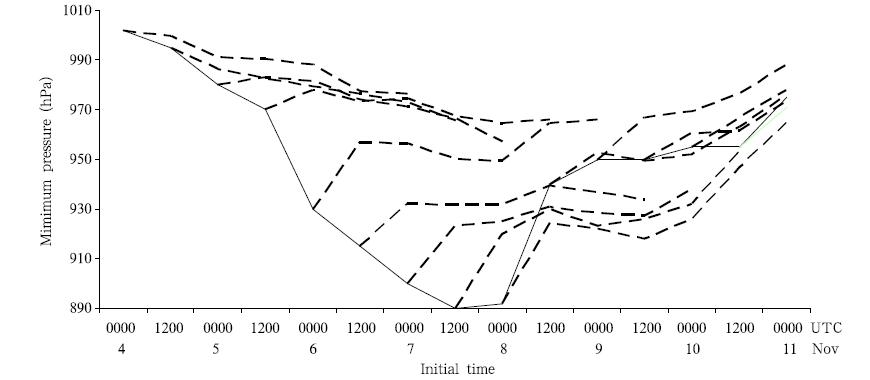 |
| Fig. 4. Time series of the minimum central pressure(hPa)of Typhoon Haiyan predicted by TRAMS. The solid and dashed lines denote the observed and forecasted results, respectively. |
The strong winds of Haiyan caused heavy destruction when it made l and fall in the Philippines, as mentioned above. Its subsequent l and fall in Quang NinhProvince in northern Vietnam brought strong winds(reaching hurricane level) and heavy rainstorms. Themaximum wind force reached 33 m s-1 when Haiyanentered Ningming County, Guangxi, China. Haiyaneventually weakened to be a tropical storm, with amaximum wind force of 23 m s-1 at 0300 UTC 11November, and thereafter weakened to a tropical depression in Guangxi 9 h later(1200 UTC 11 November). According to ground station observations fromFangcheng Port, Qinzhou, Chongzuo, and Beihai, themaximum wind speed ranged from 18 to 30 m s-1during the time when the typhoon passed throughGuangxi. As can be seen from the wind field forecastsat 925 hPa and surface(10 m), the wind direction wasbasically correctly simulated, but the wind speed wasslightly lower. With the weakening and northeastwardmovement of the typhoon, the wind speed weakenedaccordingly, and this reflected the actual situation.
During the period from the typhoon entering theBeibu Gulf to its l and fall in northern Vietnam, heavyprecipitation occurred in coastal areas of Guangxi(Fig. 5). The areas with precipitation greater than50 mm were mainly located in Nanning City and southwestern Guangxi, and there were three stationswith precipitation amounts greater than 200 mm, fromFangcheng Port to Chongzuo City, along the China-Vietnam border. After the typhoon entered Guangxi(from 0000 UTC 11 to 0000 UTC 12 November), the precipitation was mainly distributed in southwestern Hunan and most parts of Guangxi, with a rainstorm center(reaching > 200 mm)in central Guangxi. TRAMS successfully forecasted the 48-h accumulatedprecipitation in Guangxi and Hunan. The rainstormcenters, with precipitation of 150-200 mm over theYoujiang River valley, Guangxi, and 86% of rainstormstations in Guangxi, were also predicted. The fallingareas and occurrence times of strong precipitationcaused by the typhoon during l and fall were basicallycorrectly forecasted by TRAMS(Fig. 5).
 |
| Fig. 5. (a)24-h accumulative precipitation and corresponding 24-h forecast from 0000 UTC 10 to 0000 UTC 11November 2013, and (b)24-h accumulative precipitation from 0000 UTC 11 to 0000 UTC 12 November 2013 and corresponding 48-h forecast. Shadings denote the model forecast; contour lines denote the observation; colored barsdenote the forecast precipitation level(mm). |
The evolution of the large-scale circulation for Super Typhoon Haiyan is generally described by the dynamic framework in the TRAMS model. Details suchas the changes in movement speed and typhoon intensity, as well as recurving of the typhoon track, canalso be described well after physical processes wereadded. Strong exchanges of water vapor, heat, and momentum between the sea surface and the atmosphere are driven by the cyclonic circulation and warmcore of the typhoon. The exchange process takes placein the atmospheric boundary layer, and then cumulusconvection is triggered. The impacts of technical improvements in the model(namely, the boundary layerscheme and cumulus convection scheme, with otherrelevant technologies taken into account)are discussedin this section. 4. 1. 1 Boundary layer scheme
The MRF boundary layer parameterizationscheme in the old version of TRAMS simply employedthe Monin-Obukhov(M-O)similarity theory when calculating the surface layer flux(see Eq. (1)). Modification was made by using the scheme proposed by Beljaars(1994), as shown in Eq. (2)(Dai and Chen, 2013):
where C is a constant(taken as 2. 0); θvg and θva arethe virtual potential temperatures of the ground sur-face and the bottom layer of the model, respectively; h is the height of the boundary layer; g=T representsthe buoyancy effect; and v is the sum of sensibleheat flux and latent heat flux from the ground surface(
v is the sum of sensibleheat flux and latent heat flux from the ground surface( ). From Eq. (1), itcan be seen that the calculation of w* is only relatedto the gradient of the virtual potential temperature ofthe ground surface and the bottom layer of the model. Firstly, the bottom-layer virtual potential temperature(θva)has a good relationship with the model layering, and this will affect the calculation of w¤; different underlying surface types will also have a significant influence on the virtual potential temperature(θvg)ofthe ground surface, which will easily cause deviation ofthe calculation. Whereas, the calculation of the convection speed in Eq. (2)is directly correlated withthe ground surface heat flux and the boundary layerheight, so the convection speed controls the development of turbulence and the boundary layer directly. The physical meaning of Eq. (2)is more evident, and the defect in Eq. (1)can be avoided.
). From Eq. (1), itcan be seen that the calculation of w* is only relatedto the gradient of the virtual potential temperature ofthe ground surface and the bottom layer of the model. Firstly, the bottom-layer virtual potential temperature(θva)has a good relationship with the model layering, and this will affect the calculation of w¤; different underlying surface types will also have a significant influence on the virtual potential temperature(θvg)ofthe ground surface, which will easily cause deviation ofthe calculation. Whereas, the calculation of the convection speed in Eq. (2)is directly correlated withthe ground surface heat flux and the boundary layerheight, so the convection speed controls the development of turbulence and the boundary layer directly. The physical meaning of Eq. (2)is more evident, and the defect in Eq. (1)can be avoided.
The influence of the improved convection speedon the forecast of Haiyan is mainly reflected in therapid weakening process of the typhoon; thus, the forecasts initiated at 0000 UTC 7 November are analyzed. Figure 6 shows the difference of the 72-h forecast between the original scheme and the modified scheme, inwhich it can be seen that the track forecast differs little between the two within the first 48 hours, but themodified scheme has an evident advantage after 48 h, with a maximum improvement of 23. 5 km and 12%decrease in track error. The modified scheme is alsoclearly better than the original scheme in terms of theintensity forecast; the 48-h central pressure forecast oftyphoon using the modified scheme is 11 hPa lowerthan that using the original scheme, and the intensityerror decreases by 23%.
The convection speed directly influences thetransfer of flux(sensible heat, latent heat, and momentum)upwards from the sea surface, and plays animportant role in the development and maintenance ofthe typhoon. Numerical experiments revealed that theupward transferred momentum flux, latent heat flux, and sensible heat flux obtained by using the originalscheme are larger than those obtained by using themodified operational scheme(figure omitted). Thiscould perhaps explain why the original scheme sim-ulated the typhoon intensity to weaken more slowly(Haiyan started weakening after 0000 UTC 8 November) and has larger errors compared with the typhoonintensity simulated by the modified scheme.
 |
| Fig. 6. Di®erences in the forecast(a)track error(km) and (b)intensity error(hPa)for Typhoon Haiyan up to 72-hforecast time(original scheme minus the modified scheme). |
The cumulus convective parameterization schemeused in TRAMS is the SAS scheme developed by Pan and Wu(1995). Han and Pan(2011)modified the SASscheme in a number of aspects, including: defining theconvective inhibition as a function of cloud-base vertical speed; defining the entrainment rate to graduallydecrease with height; taking into account the inhibition effect of the dry air layer at the cloud base upontriggering of convection; setting the cloud-base massflux to meet local CFL(Courant-Friedrichs-Lewy)criteria; considering the influence of the horizontal pressure gradient force induced by convection on momentum transfer; and taking into account the detrainmentof cloud water and snow.
The modified SAS scheme has a very significanteffect on the forecasting of most typhoons, but its effect on the forecast of Super Typhoon Haiyan is not soobvious, due to its symmetric structure and vigorousconvection. The SAS scheme also has a few deficienciesin the coupling of stratiform cloud and cumulus. Onlythe entrainment and uplift effects of the ascendingcurrent on water vapor are taken into account in theoriginal SAS scheme, while the entrainment process ofcloud water and cloud ice is ignored when the ascending current passes through the stratiform cloud. It isequivalent to say that the SAS scheme only gives consideration to the one-way coupling process of subgrid-scale convective cloud to stratiform cloud and neglectsthe reaction of large-scale stratiform cloud on convective cloud.
Based on the analysis above, processes were added(the entrainment and uplift processes of cloud water, cloud ice, and snow in the convective ascendingcurrent; and the microphysical transformation processfrom cloud water and cloud ice to rain and snow during uplift)to improve the coupling mechanism betweenstratiform cloud and convective cloud. The influenceof the modified convective parameterization schemewas investigated with the forecast initiated at 0000UTC 7 November.
Comparison of the mean tendency between theconvective parameterization and the microphysicalprocess reveals that the original cumulus convectivescheme only generates cloud ice(qi) and ignores thetransformation process from cloud ice to snow(qs). The uplift effect of convective ascending current oncloud ice and the transformation process from cloudice to snow during the uplifting process were takeninto account in the modified scheme. The height ofthe microphysical process tendency in the new schemeis higher than that in the original scheme(figure omitted)due to the uplift effects of convection. A similarconclusion can be obtained from the change in tendency of cloud water and rain. Cloud droplets growquickly through coagulation during uplift, and theyare detrained to form stratiform cloud near the topof convective cloud, forming grid precipitation in themicrophysical process. These detrained cloud dropletsbecome larger through further coagulation during thefalling process, and so it should be the case that thegrid precipitation produced by the modified scheme isstronger than that forecasted by the original scheme. From Fig. 7, it can be seen that the grid precipitationfrom the new scheme is indeed enhanced. Finally, a72-h forecast was conducted to evaluate the influenceof the modified scheme. It was found that the modified scheme can provide a better intensity forecast, whereas the improvement of the track forecast is notso obvious.
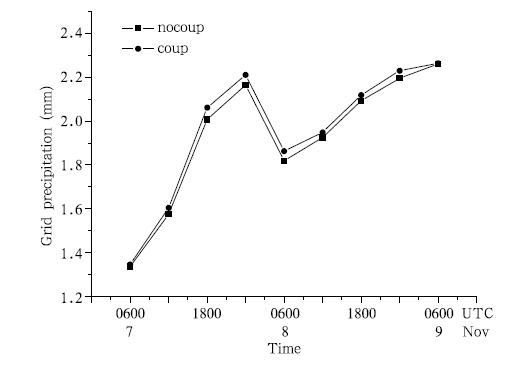 |
| Fig. 7. Time series of hourly grid-point forecasted pre-cipitation(mm)averaged within a 300-km radius of thetyphoon center, from the experiments with the original cu-mulus convection scheme(nocoup) and the modified con-vection scheme(coup). |
The influence of gravity-wave drag induced bysubgrid-scale orography(hereafter referred to asGWDO)is parameterized in TRAMS. It has beenfound that obvious deviation will occur in simulations of wind fields without consideration of GWDO. Zhong et al. (2014)introduced a GWDO parameterization scheme that was originally proposed by Kim and Arakawa(1995)into TRAMS, and found that itimproved the forecast of typhoon track and intensity, especially in longer-term forecasts. Stress will be generated at the reference level when air currents surmount irregular terrain. The stress will develop alongthe vertical direction in the form of gravity waves, and will be broken when encountering unstable conditions, which in turn will weaken the drag force and cause thegravity waves to propagate downstream. The accuracy of forecasts is raised after the gravity-wave dragis taken account into TRAMS, and this effect will bemore significant with longer integration of the model.
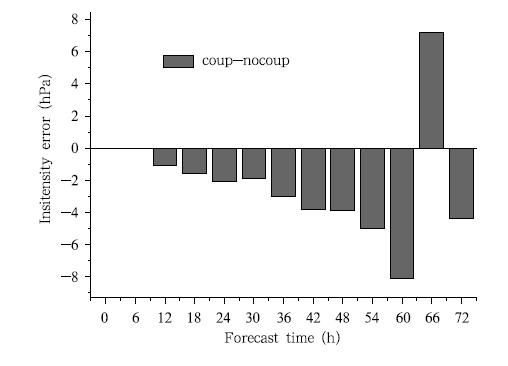 |
| Fig. 8. Comparison of the forecast errors for the cen-tral pressure(hPa)of the typhoon from the two experi-ments with the modified scheme minus that with the orig-inal scheme. |
Comparison experiments were conducted to investigate the influence of GWDO on the forecast ofHaiyan. The results showed that the forecasts of thetyphoon's track and intensity improved after GWDOis taken into account. The improvement on the forecast became evident after 48 h in the forecast initiated at 0000 UTC 7 November, with a decrease of10-20 km in the track forecast error. Consideration ofGWDO also improved the track forecast when Haiyanmade l and fall in Vietnam. In general, taking GWDOinto account improves the forecasting capability ofTRAMS.
The setting up of a reference atmosphere in numerical models also has an obvious influence on typhoon forecasts. The design of the initial perturbationon the temperature of the reference atmosphere wasstudied based on the effect of the warm sea surface and warm core structure in the typhoon. The reference atmosphere used in TRAMS was based on the static balance assumption(adopted in GRAPES-meso). Themain purpose of introducing the reference atmospherewas to eliminate the static balance component in thevertical motion equation, such that the "maxterm balance" between gravity and the pressure gradient inthe vertical motion equation was converted into the"minterm balance" of the corresponding perturbation, which should improve the accuracy of the calculation. The reference atmosphere was static in the integration of the model, so only the perturbation componentwas in fact calculated. The pressure perturbation wasused to calculate the potential temperature perturbation through the static balance relationship, which ishelpful to improve the model stability and large-scaleforecast effect. However, it will lead to obvious errorsin the forecasting of temperature at the lower level. To alleviate this problem, the potential temperatureperturbation was calculated by using Eq. (3)for thelower level, while at the middle and upper levels theoriginal scheme was still employed. The transition between the lower level to the middle and upper levels was smoothly interpolated. The modified schemeraised the accuracy of the temperature at the lowerlevel and maintained the model's forecast stability. Itwas found through a batch size test that the modifiedscheme improves the performance of TRAMS.
where µ0(λ, φ, , t), θ(λ, φ,
, t), θ(λ, φ,  , t), and
, t), and  (z)represent theperturbation of potential temperature, the full amount and reference amount of potential temperature, respectively. In the forecast of Haiyan initiated at 0000UTC 7 November, the performance of the modifiedscheme was better than the original scheme, and theerror of the track forecast was obviously reduced withthe new scheme. 4. 2 High-resolution simulation experiment
(z)represent theperturbation of potential temperature, the full amount and reference amount of potential temperature, respectively. In the forecast of Haiyan initiated at 0000UTC 7 November, the performance of the modifiedscheme was better than the original scheme, and theerror of the track forecast was obviously reduced withthe new scheme. 4. 2 High-resolution simulation experiment
A high-resolution numerical experiment was conducted with all the options set to be the same as thosein the operational TRAMS, except that the modelrange was reset to 0. 8°-20. 6°N, 113. 0°-141. 8°E and the horizontal resolution of the model was improvedfrom 0. 36° to 0. 09°. The high-resolution simulationwas initiated at 0000 UTC 7 November and integratedfor 36 h, i. e., during the period when Haiyan developedto its strongest and passed through the Philippinesrapidly.
The simulation by the high-resolution model wasvery close to the analysis field, and the changes intrack and intensity were basically consistent with observations. As can be seen from Fig. 9, the errorof the track forecast in the high-resolution simulationwas smaller than that from the operational TRAMS(36 km).
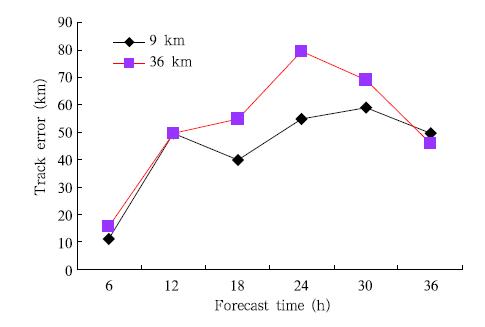 |
| Fig. 9. Comparison of the track forecast errors(km)between the 9- and 36-km resolution models, with an ini-tiation time of 0000 UTC 7 November 2013. |
The rapid intensification of Haiyan forecasted bythe model was close to the observation. The centralsea surface pressure of the typhoon decreased rapidlyafter 0000 UTC 7 November(Fig. 10), and reachedits minimum at 2200 UTC 7 November. When Haiyanmade l and fall in the Philippines(the predicted time ofl and fall was 2300 UTC 7 November, which was consistent with the actual situation), the central pressurerose rapidly and the typhoon intensity decreased obviously.
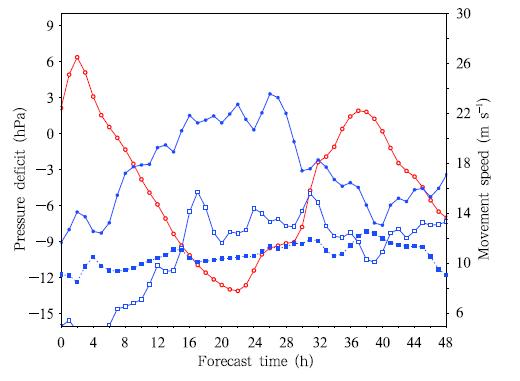 |
| Fig. 10. Evolution of deviation of the typhoon's centralsea surface pressure relative to the initial value(red line), and the typhoon movement speed(blue dotted line withsquares). Blue solid line: mean easterly wind averagedwithin a 300-km radius of the typhoon center(solid dots:3-km height; hollow dots: 8-km height). |
On the whole, the easterly wind was strong in themiddle and lower troposphere and weak in the uppertroposphere around the typhoon, which correspondedclosely to the typhoon's intensity change. The movement speed of the typhoon showed an obvious correlation with the wind speed at the middle and upper levels. The movement speed of the typhoon forecasted bythe model changed relatively smoothly(dotted curvein Fig. 10), ranging from 30 to 46 km h-1(8. 3-12. 8 ms-1). Typhoon Haiyan moved westward quickly, and the movement speed was very close to actual measurements.
At 1200 UTC 7 November, there were two warmcores at heights of 8 and 14 km, respectively(Fig. 11a). From the analysis of the flow field, it is foundthat the inflow into the lower level and outflow fromthe upper level were very obvious. The warm core ofthe typhoon was concentrated at the upper level(12-16 km)when the typhoon was strongest at 0000 UTC8 November(Fig. 11b), and the height of the warmcore was roughly the same as the level of the divergentoutflow. When the typhoon weakened at 1200 UTC 8November(Fig. 11c), the intensity of the warm core and divergent outflow also decreased evidently. Therapid intensification of Haiyan(from 1200 UTC 7 to0000 UTC 8 November)was likely to be caused by thestrong outflow from the upper level and the obviouslywarm core. The typhoon entered a rapid weakeningstage after 0000 UTC 8 November, with the outflowfrom the upper level and warm core of the typhoonaccordingly becoming weaker.
 |
| Fig. 11. Radius-height profiles along the typhoon centerfrom the simulation experiment. The wind vectors rep-resent relative storm flow(m s-1)(with movement speedsubtracted), and the shadings represent the temperatureanomalies(K)of the relative isohypsic surface. (a)1200UTC 7 November, (b)0000 UTC 8 November, and (c)1200UTC 8 November. |
The rapid intensification of Haiyan had an obvious relationship to the upper-level warm core(Fig. 12). At 2000 UTC 7 November, the upper-level warmcore was strongest and the temperature deviation exceeded 10 K. The formation of the upper-level warmcore caused the decrease in the central pressure and rapid intensification of the typhoon. In analyzing therapid intensification of Hurricane Wilma(Zhang and Chen, 2012; Chen and Zhang, 2013), which occurredin 2005, the important role of the warm core formedat the upper level was explained in detail. The relationship between the upper-level warm core and thedescent of the stratospheric current was highlighted, which was more important than the warm column inthe lower layer for the rapid intensification of the typhoon. With the gradual increase of the typhoon's intensity during 0400-1000 UTC 7 November, the warmcore ascended to heights of 6-8 km. When Haiyanreached its maximum intensity, the warm core formedat heights of 12-14 km and the warm bias was muchmore obvious than at the middle or lower level. Dueto the existence of the vigorous upper-level warm core, Haiyan maintained its intensity after passing throughthe Philippines.
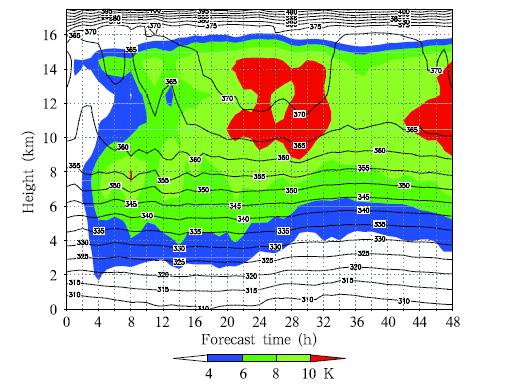 |
| Fig. 12. Time series of the simulated area-mean tempera-ture and time-height profile of potential temperature. Thepotential temperature line is plotted at every 5 K, and thecolor shadings represent the variation of the central tem-perature of the typhoon, which is the deviation from themean temperature at the initial time averaged within thearea of 700 km £ 700 km enclosing the typhoon center. |
Through an analysis of the isentropic surface inHurricane Wilma, Zhang and Chen(2012)found thatthe descent of air from the stratosphere played an important role in the formation of the warm core. Theisolines of potential temperature in Typhoon Haiyanwere very dense at heights above 16 km(Fig. 12) and its vertical gradient was large. The warm airdescended obviously during the rapid intensificationperiod of the typhoon, which indicated that a largeamount of the warm stratospheric air passed throughthe troposphere top and converged in the upper layerof the typhoon. This is important with respect tothe interpretation of how the upper-level warm core ofHaiyan formed and how the rapid intensification occurred. 5. Conclusions and discussion
Super Typhoon Haiyan moved westward rapidly and entered the South China Sea after passing throughthe Philippines, and then made l and fall for a secondtime in the coastal area of northern Vietnam beforemoving northeastward. The movement speed reached35-40 km h-1 when Haiyan passed through the Philippines, which was closely simulated by the TRAMSmodel.
Both typhoons Haiyan(2013) and Megi(2010) were super typhoons that entered the South ChinaSea in the late stage of the typhoon season, makingthem worthy of study. In the numerical simulationof Haiyan, violent horizontal cyclonic circulation wascaused by the warm sea surface, the upper-level warmcore, and the powerful easterly current, which ultimately led to the rapid intensification and quickwestward movement of Haiyan.
The shortcomings remaining in the prediction ofHaiyan's track by TRAMS are that the movementspeed is too slow in the early stage and the northwarddeflection after l and fall in Vietnam is insufficient. Inaddition, the predicted intensity is too weak compared to observations. These are the main problemsthat need to be studied in terms of the development ofnumerical models for super typhoons. The analysis ofthe higher-resolution model simulations indicated thatthe descent of stratospheric warm air and the formation of the upper-level warm core may be importantfor the rapid strengthening of Haiyan, but these factors receive little attention in current typhoon models. Therefore, research on these aspects will provide important clues to improving the forecasting of supertyphoons.
Sensitivity experiments were conducted to studythe impact of NWP technology on the improvement ofthe typhoon forecast. These new technologies showedan improved effect in a batch test, and were thus introduced into the typhoon model for the South ChinaSea in 2013. The results showed that modifying themodel's configurations, including the boundary layer, cumulus, and orographic gravity-wave parameterizations, improved the forecasted results. Improving theinitial atmospheric structure and employing a highermodel resolution helped improve the prediction ofHaiyan, mainly with respect to 0-36-h forecasts.
| [1] | Beljaars, A. C. M., 1994: The parameterization of surface fluxes in large-scale models under free-convection. Quart. J. Roy. Meteor. Soc., 121, 255-270. |
| [2] | Chen, H., D.-L. Zhang, J. Carton, et al., 2011: On the rapid intensification of Hurricane Wilma (2005). Part I: Model prediction and structural changes. Wea. Forecasting, 26, 885-901. |
| [3] | —-, and —-, 2013: On the rapid intensification of Hur-ricane Wilma (2005). Part II: Convective bursts and the upper-level warm core. J. Atmos. Sci., 70, 146-172. |
| [4] | Chen Dehui, 1995: New advance in forecast of tropical cyclone. Meteor. Sci. Technol., 22, 7-12. (in Chinese) |
| [5] | —-, Wang Shiwen, and Wan Houjun, 1996: Performance of parameterization of sub-scale physical process in numerical model and its effects on typhoon track forecasting. J. Appl. Meteor. Sci., 7, 1-8. (in Chinese) |
| [6] | Dai Guangfeng and Chen Zitong, 2013: Sensitive exper-iments of the surface flux on a simulated typhoon in GRAPES. J. Trop. Meteor., 29, 403-410. (in Chinese) |
| [7] | Han, J., and H. L. Pan, 2011: Revision of convection and vertical diffusion schemes in the NCEP global forecast system. Wea. Forecasting, 26, 520-533. |
| [8] | He Bin, 2006: Sensitive experiments of Typhoon “MATSA” to parameters used in WRF model. Memoir of Parallel Sessions “Mesoscale Weather Dynamic, Numerical Simulation, and Prediction,” Annual Meeting of the Chinese Meteorological Soci-ety, Chengdu, 25-27 October 2006, Chinese Meteor. Soc., 283-289. |
| [9] | He Huiqing, Wang Zhenhui, Jing Zhengrun, et al., 2011: The impact of cumulus parameterizations and mi-crophysics schemes under different combinations on typhoon track prediction. J. Trop. Meteor., 17, 113-119. (in Chinese) |
| [10] | Kaplan, J., and M. DeMaria, 2003: Large-scale charac-teristics of rapidly intensifying tropical cyclones in the North Atlantic basin. Wea. Forecasting, 18, 1093-1108. |
| [11] | Kasahara, A., 1957: The numerical prediction of hur-ricane movement with the barotropic model. J. Meteor., 14, 386-402. |
| [12] | Kim, Y. J., and A. Arakawa, 1995: Improvement of orographic gravity wave parameterization using a mesoscale gravity wave model. J. Atmos. Sci., 52, 1875-1902. |
| [13] | Ma Yufen, Shen Tongli, Ding Zhiying, et al., 2009: Nu-merical simulation and orographic sensitive experi-ments of Typhoon Saomai during landfall. J. Nan-jing Inst. Meteor., 32, 277-286. (in Chinese) |
| [14] | Ni Yunqi, Jin Hanliang, and Xue Zhongyuan, 1981: An operational numerical forecasting scheme of typhoon tracks over the western Pacific and its preliminary results. Chinese J. Atmos. Sci., 5, 281-291. (in Chinese) |
| [15] | Pan, H. L., and W. S. Wu, 1995: Implementing a mass flux convective parameterization package for the NMC medium range forecast model. NMC Office Note 409, 40 pp. |
| [16] | Pun, I.-F., I.-I. Lin, and M.-H. Lo, 2013: Recent increase in high tropical cyclone heat potential area in the western North Pacific Ocean. Geophys. Res. Lett., 40, 4680-4684. |
| [17] | Rogers, R., 2010: Convective-scale structure and evolu-tion during a high-resolution simulation of tropical cyclone rapid intensification. J. Atmos. Sci., 67, 44-70. |
| [18] | Shi Lijuan, Xu Xiaofeng, Li Bai, et al., 2009: Application of Doppler radar data to the simulation of land-falling Typhoon Saomai. J. Appl. Meteor. Sci., 20, 257-266. (in Chinese) |
| [19] | Wang Kangling, Xue Jishan, and Liang Yanzhao, 1987: Split semi-implicit integration of tropical limited area multi-level primitive equation model. Acta Me-teor. Sinica, 1, 123-132. |
| [20] | Wang Shiwen and Li Jianjun, 1994: Experiments of real-time numerical weather prediction of typhoon tracks. J. Appl. Meteor. Sci., 5, 462-469. (in Chi-nese) |
| [21] | Xu Yinglong, Zhang Ling, and Gao Shuanzhu, 2010: The advances and discussions on China operational ty-phoon forecasting. Meteor. Mon., 36, 43-49. (in Chinese) |
| [22] | Xue Jishan, Wang Kangling, Wang Zhiming, et al., 1988: Test of a tropical limited area numerical prediction model including effect of real topography. Adv. At-mos. Sci., 5, 1-23. |
| [23] | —-, —-, and He Anguo, 1996: Upgrade of tropical limited-area numerical model and application in ty-phoon forecast. J. Appl. Meteor. Sci., 2, 120-128. (in Chinese) |
| [24] | Yu Yubin, Duan Haixia, Yan Lijun, et al., 2008: Nu-merical simulation of rapid intensification change of Super Typhoon Saomai (2006) over the coastal water of China. Chinese J. Atmos. Sci., 32, 1365-1378. (in Chinese) |
| [25] | Zhang, D.-L., and H. Chen, 2012: Importance of the upper-level warm core in the rapid intensification of a tropical cyclone. Geophys. Res. Lett., 39, L02806, doi: 10.1029/2011GL050578. |
| [26] | Zhong Shuixin, Chen Zitong, Dai Guangfeng, et al., 2014: Impacts of orographic gravity wave drag pa-rameterization on the intensity and path forecasting of typhoon. Chinese J. Atmos. Sci., 38, 273-284. (in Chinese). |
| [27] | Zhu Yongti, Xu Yiming, Hu Fuquan, et al., 1982: An ex-periment in numerical forecasting of typhoon tracks with nested models. Acta Meteor. Sinica, 40, 257-270. (in Chinese) |
 2014, Vol. 28
2014, Vol. 28




